For additional information relating to this article, please contact:
September 29, 2020NOVA SCOTIA ANNUAL POPULATION ESTIMATES AS OF JULY 1, 2020 As of July 1, 2020, Nova Scotia's population is estimated to be 979,351, an increase of 9,604 (0.99%) over the revised July 1, 2019 estimate (969,747). Population estimates for July 1 and components of population change in the 12 months up to July 1 are conventionally referred to as 'annual' population estimates.
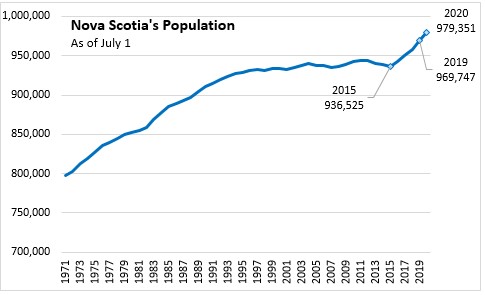
National population growth was 1.10 per cent from July 1, 2019 to July 1, 2020. The fastest growth was observed in Prince Edward Island while Newfoundland and Labrador was the only province with declining population. Population growth slowed in all provinces except Newfoundland and Labrador, where the pace of population decline slowed.

Last year's population increase of 9,604 was the third largest population growth (July 1 to July 1) since 1971.

In percentage terms, Nova Scotia's growth of 0.99 per cent was slower than the pace reported from July 1, 2018 to July 1, 2019.
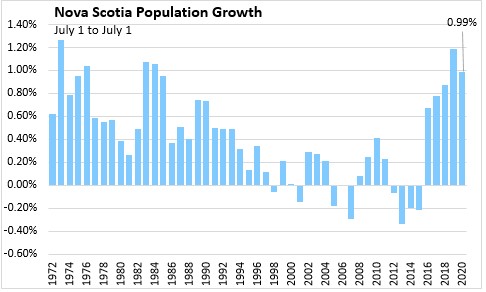
Nova Scotia's population grew last year as births, immigrants, net interprovincial migrants and net non-permanent residents outpaced declines from deaths and emigration.
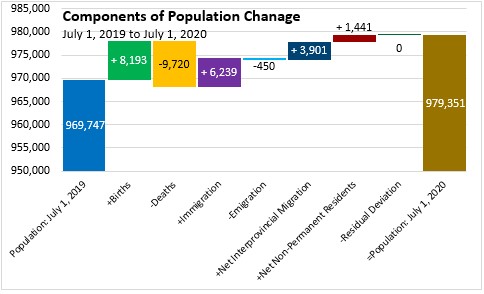
Natural population change (births less deaths) put continued downward pressure on Nova Scotia's population. From July 1, 2019 to July 1, 2020 there were 8,193 births and 9,720 deaths, resulting in a net natural population change of -1,527 over this period.
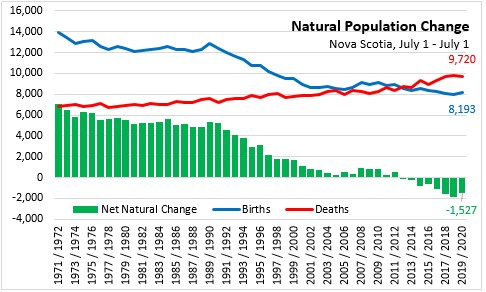
From July 1, 2018 to July 1, 2019, Nova Scotia reported the strongest annual period for immigration on record since comparable records started after the second world war. In the year up to July 1, 2020 a total of 6,239 immigrants added to Nova Scotia's population - the second highest annual immigration (July 1 to July 1) in postwar records.

In addition to 6,239 immigrants, net changes in non-permanent residents added a further 1,441 to Nova Scotia's population from July 1, 2019 to July 1, 2020. Net change in non-permanent residents (which includes students and temporary foreign workers) slowed considerably from 2018/2019. Immigration and net non-permanent residents added far more to the population than estimated net emigration of 450. Overall net international population change contributed 7,230 to Nova Scotia's population over the last year.
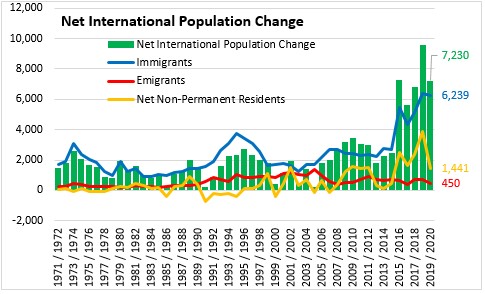
The period from July 1, 2019 to July 1, 2020 marked the fifth consecutive year of positive net interprovincial migration to Nova Scotia. There haven't been five consecutive years of positive net interprovincial migration in records dating back to 1971. The number of in-migrants to Nova Scotia from other provinces rose to 17,582 while the number of out-migrants from Nova Scotia was 13,681 (also up). Net interprovincial migration added 3,901 to the population over the period from July 1, 2019 to July 1, 2020.
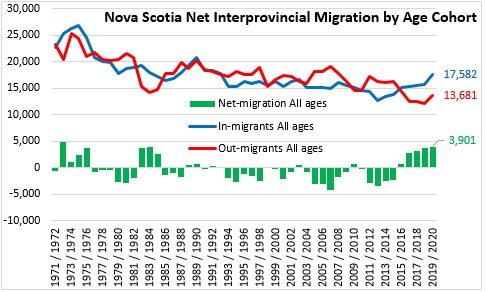
There was net positive interprovincial migration for almost all age cohorts. Net interprovincial migration of children (aged 0-14) contributed 589 to Nova Scotia's population from July 1, 2019 to July 1, 2020. Youth interprovincial migration (ages 15-34) was positive at +921 over this period. Youth are notably more mobile than other age cohorts. Net migration of those aged 35-49 was also positive at +681 while there was continuted increase in net migration of those aged 50-64 (+1,240) and those aged 65+ (+470).

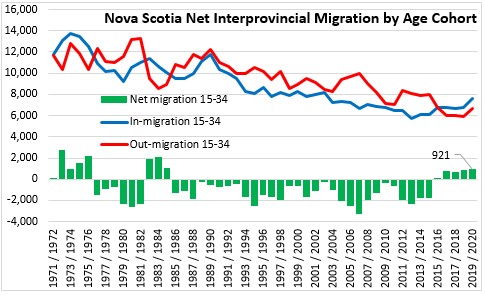
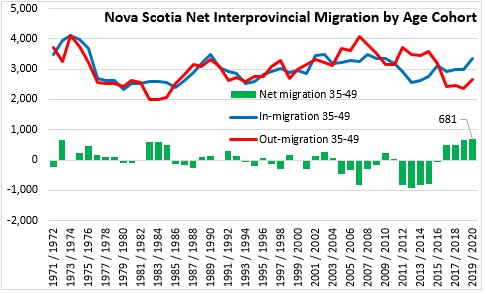
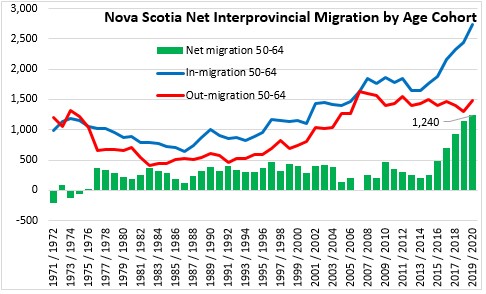
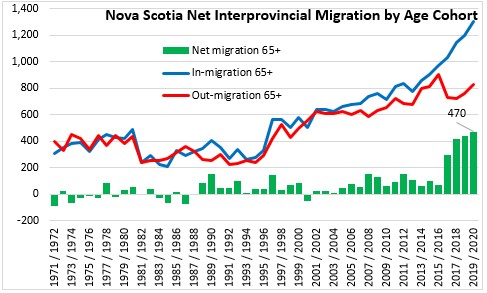
By source and destination, Nova Scotia's net interprovincial migration had positive contributions from all provinces except Quebec. The largest sources of net interprovincial migration to Nova Scotia were Ontario, Alberta, British Columbia and Newfoundland and Labrador.

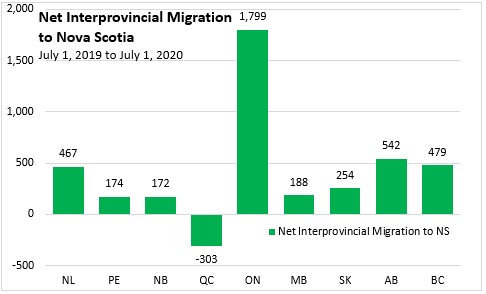



After declining from July 1, 2018 to July 1, 2019 Nova Scotia's median age was stable at 45.0 years as of July 1, 2020. This is the third highest median age among provinces.
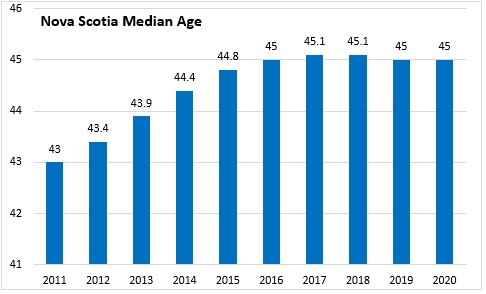
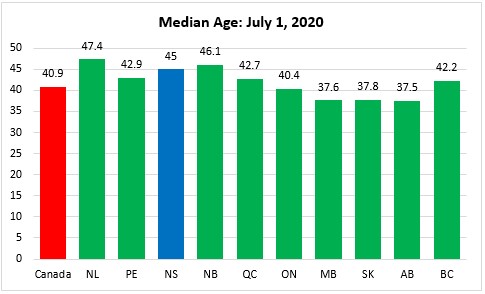
Immigration and net interprovincial migration have contributed to a reversal in declining populations of Nova Scotia's younger cohorts, particularly for those aged 18-39.

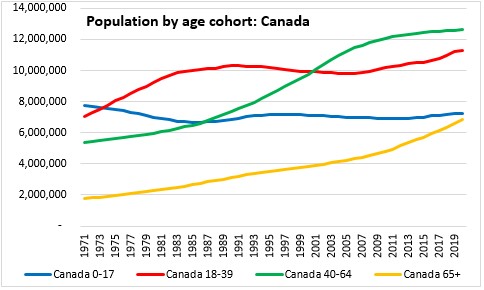
Source: Statistics Canada. Table 17-10-0005-01 Population estimates on July 1st, by age and sex, Table 17-10-0008-01 Estimates of the components of demographic growth, annual, Table 17-10-0014-01 Estimates of the components of international migration, by age and sex, annual, Table 17-10-0015-01 Estimates of the components of interprovincial migration, by age and sex, annual, Table 17-10-0022-01 Estimates of interprovincial migrants by province or territory of origin and destination, annual, Table 17-10-0009-01 Population estimates, quarterly, Table 17-10-0040-01 Estimates of the components of international migration, quarterly, Table 17-10-0020-01 Estimates of the components of interprovincial migration, quarterly